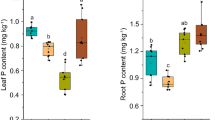Abstract
At an early stage of growth gametophytes support the sporophytes of ferns. Young sporophytes become independent of gametophytes when the first leaves develop. Although large fern gametophytes produce multiple archegonia simultaneously, only one sporophyte is typically established on one gametophyte. The number of sporophytes is believed to be controlled in two possible directions, from gametophyte to sporophyte or from preceding sporophyte to another sporophyte. To investigate the effects of gametophytes on their sporophytes, we studied the relationship between organic matter production by gametophytes and the growth of young sporophytes of Thelypteris palustris. We cut gametophytes in half (CGs) to reduce the gametophytes’ production of matter. There was no significant difference between the growth of sporophytes on intact gametophytes (IGs) and that on CGs. According to our estimates, based on the rate of organic matter production, the large gametophyte was able to produce two or more sporophytes. The resources required for CGs to make similar-sized sporophytes was twice that for IGs. In polyembryony each of the multiple sporophytes was similar in size to the single sporophytes. Resource limitation does not seem to explain why fern gametophytes establish single sporophytes.







Similar content being viewed by others
References
Albaum HG (1938) Inhibition due to growth hormones in fern prothallia and sporophytes. Am J Bot 25:124–133
Duckett JG (1979a) Comparative morphology of the gametophytes of Equisetum subgenus Hippochaete and the sexual behavior of E. ramosissimum subsp. debile, (Roxb.) Hauke, E. hyemale var. affine (Engelm.) A.A., and E. laevigatum A. Br. Bot J Linn Soc 79:179–203
Duckett JG (1979b) An experimental study of the reproductive biology and hybridization in the European and North America species of Equisetum. Bot J Linn Soc 79:205–229
Duckett JG, Duckett AR (1980) Reproductive biology and population dynamics of wild gametophytes of Equisetum. Bot J Linn Soc 80:1–40
Friend DJC (1975) Adaptation and adjustment of photosynthetic characteristics of gametophytes and sporophytes of Hawaiian tree-fern (Cibotium glaucum) grown at different irradiances. Photosynthetica 9:157–164
Ganders FR (1972) Heterozygosity for recessive lethals in homosporous fern populations: Thelypteris palustris and Onoclea sensibilis. Bot J Linn Soc 65:211–221
Hagar WG, Freeberg JA (1980) Rate of photosynthesis of sporophytes and gametophytes of the fern Todea Barbara. Plant Physiol 65:584–586
Iwatsuki K (1992) Ferns and fern allies of Japan. Heibonsha, Tokyo, p 214
Keddy PA (1981) Why gametophytes and sporophytes are different: form and function in a terrestrial environment. Am Nat 118:452–454
Lloyd RM (1974) Reproductive biology and evolution in the pteridophyta. Ann Mo Bot Gard 61:318–331
Masuyama S (1984) Reproductive biology of ferns (in Japanese). Hojo Shokan, Tokyo
Mottier DM (1925) Polyembryony in certain Polypodiaceae and Osmundaceae. Bot Gaz 80:331–336
Mottier DM (1927) Behavior of certain fern prothallia under prolonged cultivation. Bot Gaz 83:244–267
Rastorfer JR (1962) Photosynthesis and respiration in moss sporophytes and gametophytes. Pyton 19(2):169–177
Sakai S (2001) On the nature of the size-number trade-off of seeds and eggs (in Japanese). Biol sci (Tokyo) 52(4):228–236
Sakamaki Y, Ino Y (1999) Contribution of fern gametophytes to the growth of produced sporophytes on the basis of carbon gain. Ecol Res 14:59–69
Stark LR (1983) Reproductive biology of Entodon cladorrhizans (Bryopsida, Entodontaceae) I. The reproductive cycle and frequency of fertilization. Syst Bot 8:381–388
Stark LR, Stephenson AG (1983) Reproductive biology of Entodon cladorrhizans (Bryopsida, Entodontaceae) II. Resource-limited reproduction and sporophyte abortion. Syst Bot 8:389–394
Watson EV (1964) The sporophyte of mosses. In: The structure and life of bryophytes. Hutchison University Library, London, pp 77–92
Willson MF (1983) Offspring: in plant reproductive ecology. Wiley-Interscience, New York, pp 179–265
Acknowledgments
We thank the late Dr Yasuyuki Oshima for his support, valuable suggestions, and helpful advice. We are also grateful to the members of the Ecological Laboratory of Waseda University for their kind assistance and advice.
Author information
Authors and Affiliations
Corresponding author
Rights and permissions
About this article
Cite this article
Sakamaki, Y., Ino, Y. Gametophyte contribution to sporophyte growth on the basis of carbon gain in the fern Thelypteris palustris: effect of gametophyte organic-matter production on sporophytes. J Plant Res 120, 301–308 (2007). https://doi.org/10.1007/s10265-006-0062-z
Received:
Accepted:
Published:
Issue Date:
DOI: https://doi.org/10.1007/s10265-006-0062-z




